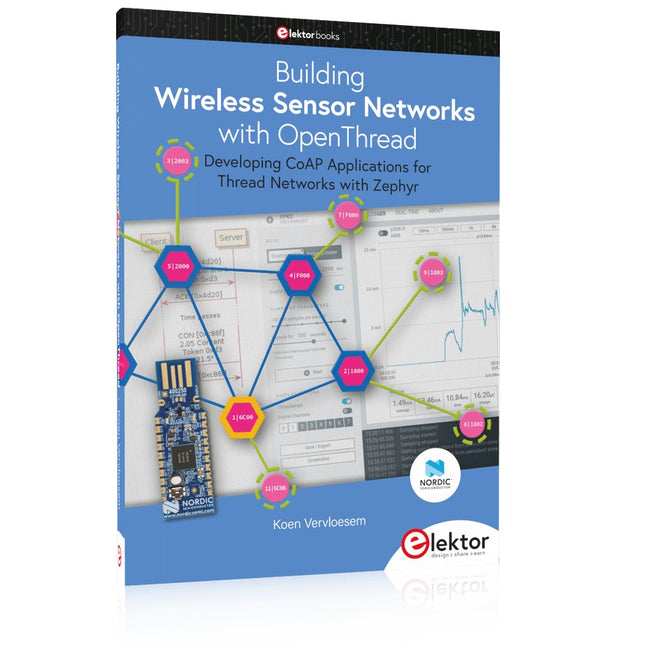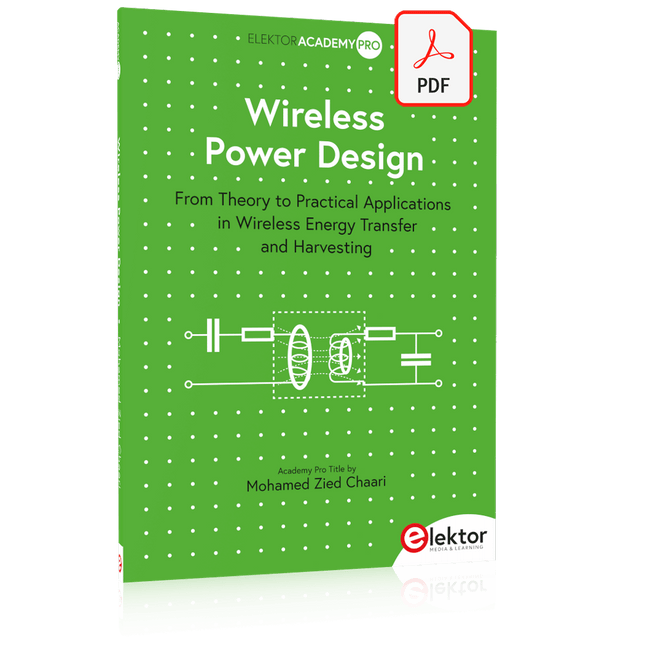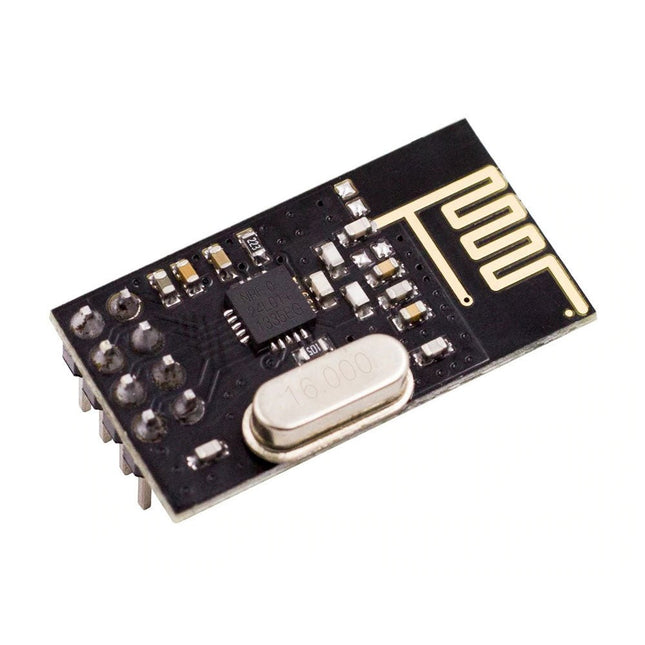Résultats de la recherche pour "130439 OR 71 OR raswik OR wireless"
-

Elektor Publishing Wireless Power Design
From Theory to Practical Applications in Wireless Energy Transfer and Harvesting Wireless power transmission has gained significant global interest, particularly with the rise of electric vehicles and the Internet of Things (IoT). It’s a technology that allows the transfer of electricity without physical connections, offering solutions for everything from powering small devices over short distances to long-range energy transmission for more complex systems. Wireless Power Design provides a balanced mix of theoretical knowledge and practical insights, helping you explore the potential of wireless energy transfer and harvesting technologies. The book presents a series of hands-on projects that cover various aspects of wireless power systems, each accompanied by detailed explanations and parameter listings. The following five projects guide you through key areas of wireless power: Project 1: Wireless Powering of Advanced IoT Devices Project 2: Wireless Powered Devices on the Frontline – The Future and Challenges Project 3: Wireless Powering of Devices Using Inductive Technology Project 4: Wireless Power Transmission for IoT Devices Project 5: Charging Robot Crawler Inside the Pipeline These projects explore different aspects of wireless power, from inductive charging to wireless energy transmission, offering practical solutions for real-world applications. The book includes projects that use simulation tools like CST Microwave Studio and Keysight ADS for design and analysis, with a focus on practical design considerations and real-world implementation techniques.
€ 39,95
Membres € 35,96
-

Elektor Publishing Building Wireless Sensor Networks with OpenThread
Developing CoAP applications for Thread networks with Zephyr This book will guide you through the operation of Thread, the setup of a Thread network, and the creation of your own Zephyr-based OpenThread applications to use it. You’ll acquire knowledge on: The capture of network packets on Thread networks using Wireshark and the nRF Sniffer for 802.15.4. Network simulation with the OpenThread Network Simulator. Connecting a Thread network to a non-Thread network using a Thread Border Router. The basics of Thread networking, including device roles and types, as well as the diverse types of unicast and multicast IPv6 addresses used in a Thread network. The mechanisms behind network discovery, DNS queries, NAT64, and multicast addresses. The process of joining a Thread network using network commissioning. CoAP servers and clients and their OpenThread API. Service registration and discovery. Securing CoAP messages with DTLS, using a pre-shared key or X.509 certificates. Investigating and optimizing a Thread device’s power consumption. Once you‘ve set up a Thread network with some devices and tried connecting and disconnecting them, you’ll have gained a good insight into the functionality of a Thread network, including its self-healing capabilities. After you’ve experimented with all code examples in this book, you’ll also have gained useful programming experience using the OpenThread API and CoAP.
€ 39,95
Membres € 35,96
-

Elektor Digital Wireless Power Design (E-book)
From Theory to Practical Applications in Wireless Energy Transfer and Harvesting Wireless power transmission has gained significant global interest, particularly with the rise of electric vehicles and the Internet of Things (IoT). It’s a technology that allows the transfer of electricity without physical connections, offering solutions for everything from powering small devices over short distances to long-range energy transmission for more complex systems. Wireless Power Design provides a balanced mix of theoretical knowledge and practical insights, helping you explore the potential of wireless energy transfer and harvesting technologies. The book presents a series of hands-on projects that cover various aspects of wireless power systems, each accompanied by detailed explanations and parameter listings. The following five projects guide you through key areas of wireless power: Project 1: Wireless Powering of Advanced IoT Devices Project 2: Wireless Powered Devices on the Frontline – The Future and Challenges Project 3: Wireless Powering of Devices Using Inductive Technology Project 4: Wireless Power Transmission for IoT Devices Project 5: Charging Robot Crawler Inside the Pipeline These projects explore different aspects of wireless power, from inductive charging to wireless energy transmission, offering practical solutions for real-world applications. The book includes projects that use simulation tools like CST Microwave Studio and Keysight ADS for design and analysis, with a focus on practical design considerations and real-world implementation techniques.
€ 32,95
Membres € 26,36
-

Pimoroni Pack sans fil Pimoroni Raspberry Pi Pico
Raspberry Pi Pico Wireless Pack se fixe à l'arrière de votre Pico et utilise une puce ESP32 pour permettre à votre Pico de se connecter aux réseaux sans fil 2,4 GHz et de transférer des données. Il existe un emplacement pour carte microSD si vous souhaitez stocker beaucoup de données localement, ainsi qu'une LED RVB (pour les mises à jour d'état) et un bouton (utile pour des choses comme activer/désactiver le Wi-Fi). Idéal pour adapter rapidement un projet Pico existant afin d'avoir une fonctionnalité sans fil, le Raspberry Pi Pico Wireless Pack serait utile pour envoyer des données de capteurs dans des systèmes domotiques ou des tableaux de bord, pour héberger une page Web à partir d'une boîte d'allumettes ou pour permettre à votre Pico d'interagir avec des API en ligne. . Caractéristiques Module ESP32-WROOM-32E pour connectivité sans fil (connecté via SPI) ( fiche technique ) 1x bouton tactile LED RVB Emplacement pour carte Micro SD Connecteurs femelles pré-soudés pour fixer votre Raspberry Pi Pico Entièrement assemblé Aucune soudure requise (tant que votre Pico est équipé de broches d'en-tête attachées) Compatible avec Raspberry Pi Pico Dimensions : environ 53 x 25 x 11 mm (L x L x H, y compris les en-têtes et les composants) Bibliothèques C++ et MicroPython
€ 17,95€ 7,18
Membres identique
-

Kuongshun Module émetteur-récepteur sans fil nRF24L01+ (2,4 GHz)
NRF24L01 est une puce émetteur-récepteur monolithique universelle en bande ISM fonctionnant dans la bande 2,4-2,5 GHz. Caractéristiques Émetteur-récepteur sans fil comprenant : Générateur de fréquence, type amélioré, SchockBurstTM, contrôleur de mode, amplificateur de puissance, amplificateur à cristal, modulateur, démodulateur La sélection du canal de puissance de sortie et les paramètres du protocole peuvent être définis avec une consommation de courant extrêmement faible, via l'interface SPI. En mode de transmission, la puissance de transmission est de 6 dBm, le courant est de 9,0 mA, le courant du mode accepté est de 12,3 mA, la consommation de courant du mode mise hors tension et du mode veille est inférieure Antenne 2,4 GHz intégrée, prend en charge jusqu'à six canaux de réception de données Taille : 15 x 29 mm (antenne comprise)
€ 7,95€ 3,18
Membres identique
-

Elektor Digital Building Wireless Sensor Networks with OpenThread (E-book)
Developing CoAP applications for Thread networks with Zephyr This book will guide you through the operation of Thread, the setup of a Thread network, and the creation of your own Zephyr-based OpenThread applications to use it. You’ll acquire knowledge on: The capture of network packets on Thread networks using Wireshark and the nRF Sniffer for 802.15.4. Network simulation with the OpenThread Network Simulator. Connecting a Thread network to a non-Thread network using a Thread Border Router. The basics of Thread networking, including device roles and types, as well as the diverse types of unicast and multicast IPv6 addresses used in a Thread network. The mechanisms behind network discovery, DNS queries, NAT64, and multicast addresses. The process of joining a Thread network using network commissioning. CoAP servers and clients and their OpenThread API. Service registration and discovery. Securing CoAP messages with DTLS, using a pre-shared key or X.509 certificates. Investigating and optimizing a Thread device’s power consumption. Once you‘ve set up a Thread network with some devices and tried connecting and disconnecting them, you’ll have gained a good insight into the functionality of a Thread network, including its self-healing capabilities. After you’ve experimented with all code examples in this book, you’ll also have gained useful programming experience using the OpenThread API and CoAP.
€ 32,95
Membres € 26,36
-

Elektor Digital Getting Started with the Intel Edison (E-book)
The Internet of Things is rapidly gaining interest, and that has fueled the development of the Edison. A tiny computer, the size of a postage stamp, with a lot of power and built-in wireless communication capabilities. In this eBook we will help you get up-to-speed with the Edison, by installing the software both on the Edison as well as on your Windows PC. We will use the Edison Arduino break-out board because it is easy to work with. We will discuss Linux, Arduino C++ and Python, and show examples of how the Edison can interface with other hardware. We will use Wi-Fi and Bluetooth to set up wireless connections, and show you a trick to program sketches over Wi-Fi. Once you have completed this book your Edison will be up and running with the latest software version, and you will have sufficient knowledge of both hardware and software to start making your own applications. You will even be able to program the Edison over USB and wireless both in Arduino C++ and Python. This is not a projects eBook, but a toolbox that will allow you to explore the wonderful world of the Intel Edison!
€ 24,95
Membres € 19,96
-

SparkFun SparkFun Thing Plus Matter (MGM240P)
La SparkFun Thing Plus Matter est la première carte facilement accessible de ce type qui combine Matter et l'écosystème Qwiic de SparkFun pour le développement agile et le prototypage de dispositifs IoT basés sur Matter. Le module sans fil MGM240P de Silicon Labs offre une connectivité sécurisée pour les deux protocoles 802.15.4 avec communication Mesh (Thread) et Bluetooth Low Energy 5.3. Le module est prêt à être intégré au protocole Matter IoT de Silicon Labs pour la domotique. Qu'est-ce que Matter ? En termes simples, Matter permet un fonctionnement cohérent entre les appareils domestiques intelligents et les plateformes IoT sans connexion Internet, même s'ils proviennent de fournisseurs différents. Ce faisant, Matter est capable de communiquer entre les principaux écosystèmes IoT afin de créer un protocole sans fil unique, facile à utiliser, fiable et sécurisé. La Thing Plus Matter (MGM240P) comprend des connecteurs Qwiic et de batterie LiPo, ainsi que plusieurs connecteurs GPIO capables d'un multiplexage complet par le biais d'un logiciel. La carte comprend également le chargeur LiPo monocellulaire MCP73831 ainsi que la jauge de carburant MAX17048 pour charger et surveiller une batterie connectée. Enfin, un emplacement pour carte µSD est intégré pour tout besoin de mémoire externe. Le module sans fil MGM240P est construit autour du SoC sans fil EFR32MG24 avec un processeur ARM Cortex-M33 à 32 bits fonctionnant à 39 MHz avec 1536 kb de mémoire Flash et 256 kb de RAM. Le MGM240P fonctionne avec les protocoles sans fil 802.15.4 courants (Matter, ZigBee et OpenThread) ainsi qu'avec Bluetooth Low Energy 5.3. Le MGM240P supporte le Secure Vault de Silicon Labs pour les applications Thread. Spécifications Module sans fil MGM240P Construit autour du SoC sans fil EFR32MG24 Processeur Cœur ARM Cortex-M33 32 bits (@ 39 MHz) Mémoire flash de 1536 Ko 256 Ko de RAM Prise en charge de plusieurs protocoles sans fil 802.15.4 (ZigBee et OpenThread) Bluetooth Low Energy 5.3 Prêt pour Matter Prise en charge de Secure Vault Antenne intégrée Facteur de forme Thing Plus (compatible avec les fibres) : Dimensions : 5,8 x 2,3 cm (2,30 x 0,9')2 5,8 x 2,3 cm (2,30 x 0,9') 2 trous de fixation : compatible avec les vis 4-40 21 sorties GPIO Tous les connecteurs ont une capacité de multiplexage complète par logiciel Interfaces SPI, I²C et UART mappées par défaut sur les connecteurs étiquetés. 13 GPIO (6 étiquetés comme analogiques, 7 étiquetés comme GPIO) Toutes les fonctions sont soit GPIO, soit analogiques. Convertisseur numérique-analogique intégré (DAC) Connecteur USB-C Connecteur de batterie LiPo JST à 2 broches pour une batterie LiPo (non incluse) Connecteur JST Qwiic 4 broches Chargeur LiPo monocellulaire MC73831 Taux de charge configurable (500 mA par défaut, 100 mA en alternance) MAX17048 Jauge de carburant LiPo monocellulaire Emplacement pour carte µSD Faible consommation d'énergie (15 µA lorsque le MGM240P est en mode faible consommation) LED: PWR - LED rouge d'alimentation CHG - Voyant jaune d'état de charge de la batterie STAT - Voyant d'état bleu Bouton de réinitialisation : Bouton-poussoir physique Le signal de réinitialisation peut être lié à A0 pour permettre une utilisation en tant que périphérique. Téléchargements Schematic Eagle Files Board Dimensions Hookup Guide Datasheet (MGM240P) Fritzing Part Thing+ Comparison Guide Qwiic Info Page GitHub Hardware Repo
€ 34,95€ 13,98
Membres identique
-

, par Jean-François Simon Modem sans fil RC-RICK-868-EV (Test)
Le RC-RICK-868 est un modem radio avec une interface UART utilisant la modulation LoRa, conçu pour une communication point à point facile.
-

, par Lobna Belarbi Affordable Robot Kits to Kickstart Your Robotics Journey
Robotics is an exciting and rewarding field, but getting started can be intimidating—especially when it comes to choosing the right kit. Fortunately, Elektor offers a...
-

, par Lobna Belarbi Kickstart Your Electronics Journey with Elektor’s Learning Collection
Whether you're new to electronics or aiming to level up your embedded skills, Elektor’s Learning Collection delivers expert-curated kits, courses, and hands-on bundles. The first...
-

, par Saad Imtiaz SparkFun Thing Plus Matter (MGM240P) : Une carte de développement IoT polyvalente basée sur "Matter" (Essai)
La "SparkFun Thing Plus Matter - MGM240P" est une carte de développement polyvalente et riche en fonctionnalités, conçue pour réaliser des appareils IoT basés sur...











